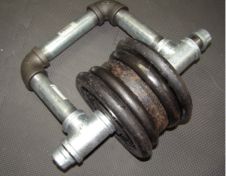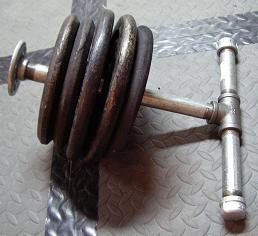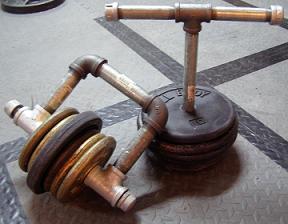| What are
Kettlebells?
The Kettlebell is a cast
iron weight, which resembles a basketball with a handle. A Russian
exercise device used for more than 100 years, Kettlebells have long been
a favorite in that country for those seeking a special edge in strength
and endurance.

In the twentieth
century Soviet science discovered that repetition
Kettlebell
lifting is one of the best tools for all around physical development.
(Voropayev, 1983) observed two groups of college students over a period
of a few years. A standard battery of the armed forces PT tests was
used: pullups, a standing broad jump, a 100m sprint, and a 1k run. The
control group followed the typical university physical training program
which was military oriented and emphasized the above exercises. The
experimental group just lifted Kettlebells. In spite of the lack of
practice on the tested drills, the Kettlebell group showed better scores
in every one of them.
There was more. Surprised researchers at the famous Lesgaft Physical
Culture Institute in Leningrad (Vinogradov & Lukyanov, 1986) found a
very high correlation between the Kettlebell lift total and a great
range of dissimilar tests: strength, measured with the three
powerlifts and grip strength; strength endurance, measured with pullups
and parallel bar dips; general endurance, determined by a 1000 meter
run; work capacity and balance, measured with special tests!
In addition to their many mentioned benefits, the official
Kettlebell lifts
also develop the ability to absorb ballistic shocks. If you want
to develop your ability to take impact try the official K-bell lifts.
The repetitive ballistic shock builds extremely strong tendons and
ligaments.
The ballistic blasts of kettlebell exercise become an excellent
conditioning tool for athletes from rough sports like kickboxing,
wrestling, and football. The extreme metabolic cost of high rep
Kettlebell workouts will put your unwanted fat on a fire sale.
Reference: Dragon Door - Strength Training
with Kettlebells
Do-it-yourself
Kettlebell design
This
design can be used as an adjustable kettlebell, allowing weights up to
35 lbs.

Parts:
-
1-1"x 6" steel nipple (handle, external diameter is 1 and 1/4")
-
2-1" 90 degree elbows (connect handle to vertical pieces)
-
2-1"x 4 1/2" steel nipple (vertical pieces), longer vertical pieces
will allow the use of
larger, heavier plates
-
2-1" 'T's
-
1-1"x12' steel nipple (through plates)
-
2-1' end caps
-
6-5
pound standard barbell plates (make sure the 3/4" pipe goes through
all of these, the hole in some of my 5 pound plates are too small to
use)
Option 2:
"T-bar" Kettlebell design
Here's another cheap and easy kettlebell
plan that I recently made. This one is especially good for
those two-arm swings. 3 pieces of 3/4" pipe, a T fitting, a
flange, and a couple of end caps and you're ready to pile on some of
those standard plates that you've had laying around. This is
an excellent conditioning tool to add to your arsenal!

As
with some dumbbells, always verify that your collars (or end caps) are
tight before using.

|
![]()